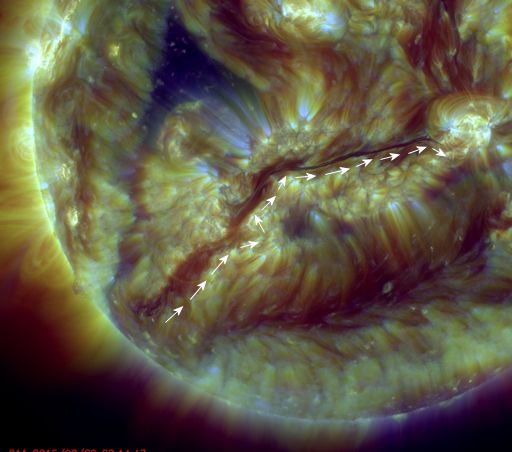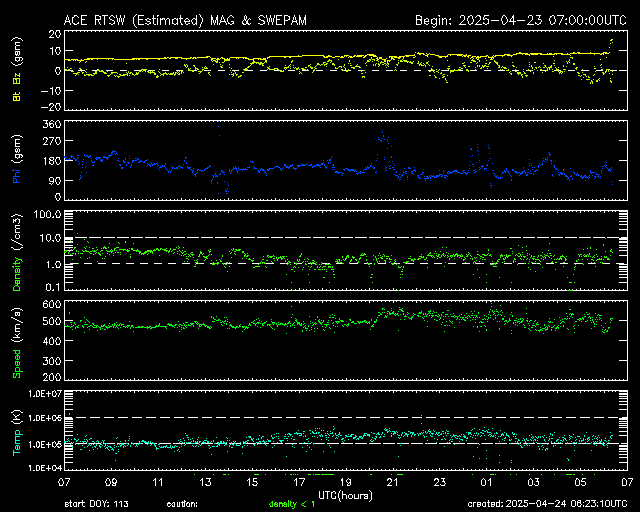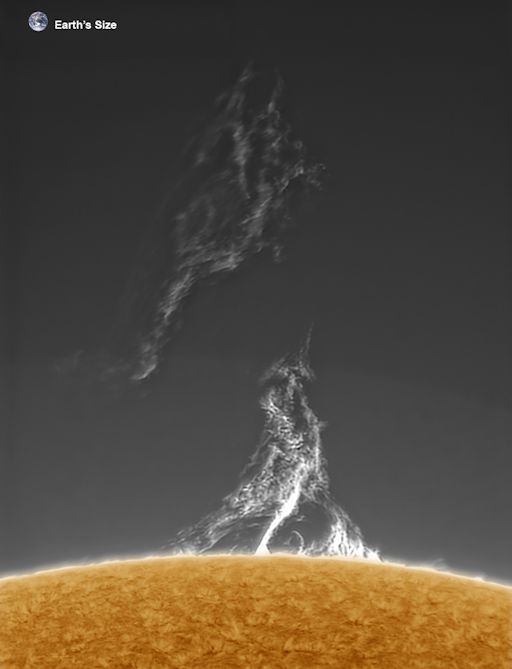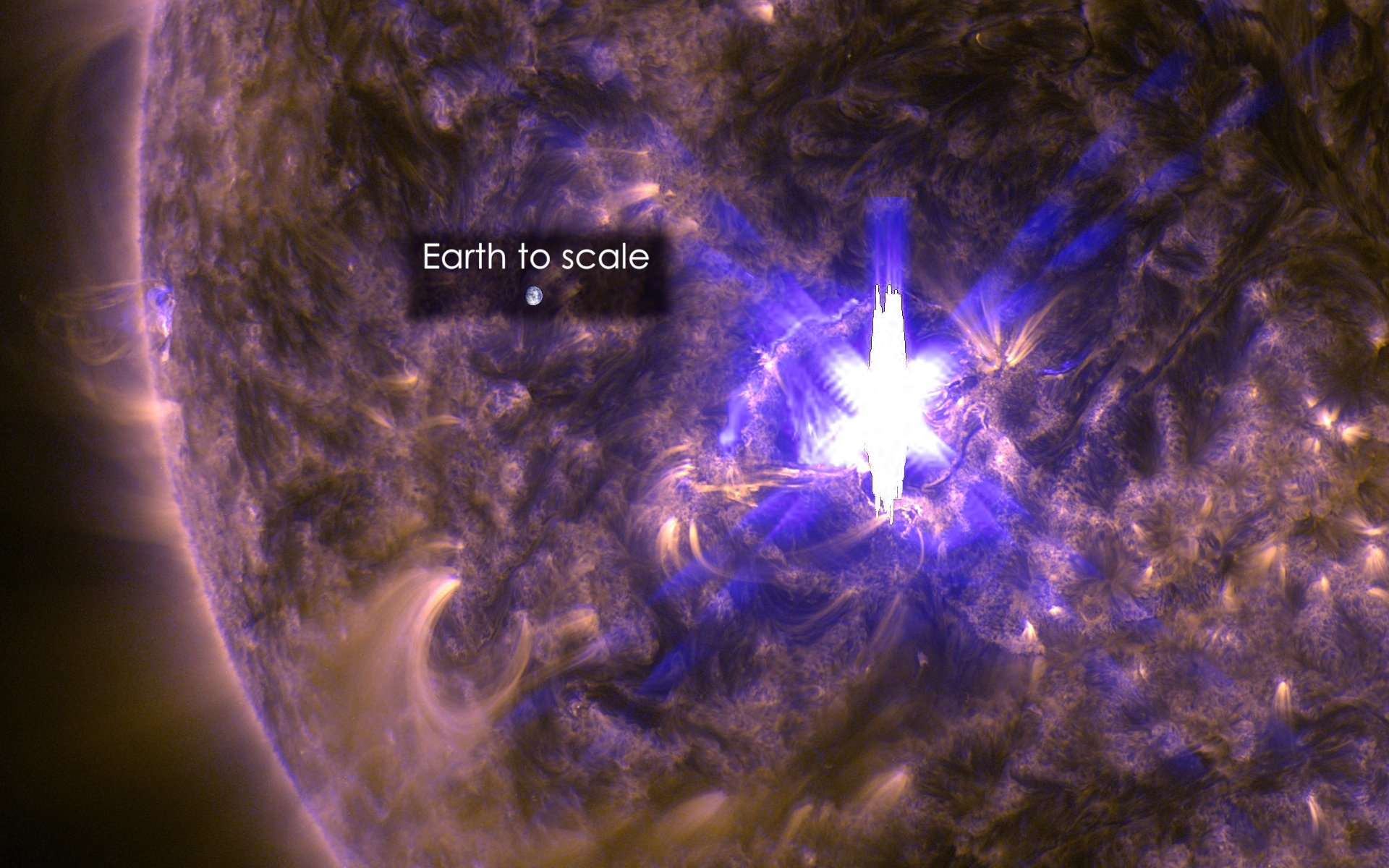Afgelopen maandag heeft de Nasa de beelden op youtube gepubliceerd.
Hij is geklasseerd op X1.8
In de video zie je heel mooi dat het oppervlak van de zon openscheurt.
http://youtu.be/BvyA6JwddPQ

Meer info vind je ook op www.poollicht.be Hier zie je de recente uitbarstingen in alle klasse en soorten. Ook berichten ze veel over poollicht en poollichtkansen
Meer info vind je ook op www.poollicht.be Hier zie je de recente uitbarstingen in alle klasse en soorten. Ook berichten ze veel over poollicht en poollichtkansen
Ik heb nog maar sporadisch op die site gekeken, wel had ik al vaker gekeken op de site, die ik hier zometeen onder vermeldt, zelf de datum kiezen kan een "zon"dag en daar is dan per golflengte te klikken hoe je de dag wilt zien.
http://sdo.gsfc.nasa.gov/data/dailymov.php
Edit Callie-p : gok dat je deze site bedoelt : http://www.suspicious0bservers.org/ | Gewijzigd: 18 januari 2015, 21:00 uur, door Callie-P

Op spaceweather.com de volgende tekst:
A giant, slinky-shaped column of magnetism has formed on the sun, shown below in an extreme UV image from NASA's Solar Dynamics Observatory
It's a dark solar filament--essentially, a tendril of plasma more than 1,000,000 km long held suspended above the surface of the sun by magnetic forces. If the filament becomes unstable and erupts, it could hurl parts of itself into space. Pieces of the filament falling back to the solar surface would explode upon impact, creating one or more Hyder flares.
Wat is een Hyder flare:
Flares are intense brightenings that occur in the solar chromosphere. Flares are generally observed from Earth using narrow band filters, typically with a bandwidth of less than 0.1 nm, and often centred on the Hydrogen-alpha wavelength of 656.3 nm. (Flares also have counterparts, that is, sudden outbursts, in the radio and X-ray spectrum).
Most flares occur around active regions associated with sunspot groups. However, occasionally a flare (sudden brightening) is observed well away from an active region or sunspot group. These flares are invariably associated with the sudden disappearance of a large (thick, long, 'bushy') dark solar filament, and are termed Hyder flares.
Dus even in de gaten houden. als dit knoepertje barst kunnen er niet alleen x klasse flares komen, maar kunnen we een mooi showtje aurora borealis verwachten (en iets minder mooi... aardbevingen die regelmatig hierop volgen).....mits het uiteindelijk aarde gericht is...
Hier een linkje naar meer info en fotos
http://www.solarham.net/ | Gewijzigd: 9 februari 2015, 20:13 uur, door Justin

http://aurora.phys.ucalgary.ca/summary_plots/slr-rt/yknf/recent_480p.jpg?1429178414

http://services.swpc.noaa.gov/images/planetary-k-index.gif

http://services.swpc.noaa.gov/images/aurora-forecast-northern-hemisphere.png | Gewijzigd: 16 april 2015, 12:06 uur, door Joyce.s
Forecasters estimate a 45% chance of geomagnetic storms when the CME arrives. Bright moonlight and summer twilight will probably overwhelm any auroras around the Arctic Circle. The Antarctic Circle is much darker. Stay tuned for SouthernLights.



http://aurora.phys.ucalgary.ca/summary_plots/slr-rt/yknf/recent_480p.jpg?1430723894
bron: spaceweather.com; solarham.net
The sun is no longer quiet. Emerging sunspot AR2339 unleashed an intense X2-class solar flare on May 5th at 22:11 UT. NASA's Solar Dynamics Observatory captured the extreme ultraviolet flash:

http://www.spaceweather.com/images2015/05may15/x2.jpg?PHPSESSID=6unf7t6gg3qj24ti8nbv5lgke7
A pulse of UV radiation and X-rays from the flare caused a strong radio blackout over the Pacific side of Earth. This map shows the extent of the blackout, which affected frequencies below 20 MHz. Mariners, aviators, and ham radio operators are the type of people who might have noticed the disturbance.
The explosion also hurled a CME into space: movie. Traveling faster than 1100 km/s (2.5 million mph), the expanding cloud does not appear to be heading for Earth. Solar flare alerts: text, voice
In addition to causing a radio blackout, the flare also caused a radio burst. Immediately after the flare, a roar of static bellowed from the loudspeakers of shortwave receivers on Pacific isles and western parts of North America. Amateur radio astronomer Thomas Ashcraft of New Mexico recorded the outburst:
http://www.spaceweather.com/images2015/06may15/SrMay052015_x2.7_2207ut22.23MHz_Ashcraft.mp3?PHPSESSID=6unf7t6gg3qj24ti8nbv5lgke7
 http://satdat.ngdc.noaa.gov/sem/goes/data/new_plots/latest/goes15/g15_summary_latest3days.jpg
http://satdat.ngdc.noaa.gov/sem/goes/data/new_plots/latest/goes15/g15_summary_latest3days.jpgBron: Noaa.gov; spaceweather.com; solarham.net | Gewijzigd: 6 mei 2015, 12:19 uur, door Joyce.s
Ik heb al vaker berichten geplaatst over de zon, aurora's etc. Mooi om te zien, maar het kan ook een enorme impact op de aarde hebben (aardbevingen, vulkaanuitbarstingen, stroomuitval, radiostoringen, impact op het aardmagnetisme, etc). Derhalve belangrijk (vind ik althans) om in de gaten te houden.
Ben Davidson van observary project heeft de moeite genomen om korte informatiefilmpjes te maken over de zon en haar impact (engelstalig).
Deel 1: Zonnewind:
Deel 2: opbouw van de zon:
Deel 3: Zonnevlekken:
Deel 4: Zonnevlammen en cme's:
Deel 5: Ruimtestraling en cme impact:
Deel 6: Mega zonnevlam:
Deel 7: Geomagnetische stormen:
Deel 8: Coronale gaten:
Deel 9: Classificatie zonnevlekken:
Deel 10: Zonnecyclus:
| Gewijzigd: 15 mei 2015, 10:42 uur, door Joyce.s
En op de K- index:

Als Ace de deeltjes detecteert, duurt het nog ongeveer 8 minuten tot ze op de aarde aankomen:

en zien we de absorptie op aarde:

Met eventuele gevolgen als genoemd in het openingsbericht, zoals aurora borealis, problemen in radio communicatie, aardbevingen, vulkaanuitbarstingen, en zelfs storingen in ons electrische netwerk.
bronnen:
http://services.swpc.noaa.gov/images/planetary-k-index.gif
http://services.swpc.noaa.gov/images/ace-mag-swepam-24-hour.gif
http://services.swpc.noaa.gov/images/animations/drap_global/latest.png
http://iswa.gsfc.nasa.gov/IswaSystemWebApp/iSWACygnetStreamer?timestamp=2038-01-23%2000:44:00&window=-1&cygnetId=40

Photo Jett Aguilar
"I used a Lunt solar telescope to image the event," says Aguilar. "It was magnificant."
NASA's Solar Dynamics Observatory (SDO) also recorded the eruption. Watch this movie. SDO captured not just one but two filaments of magnetism exploding. Both hurled CMEs into space. NOAA analysts are modeling the storm clouds to determine if they will hit Earth. Stay tuned.
bron:http://www.spaceweather.com/ | Gewijzigd: 1 februari 2017, 11:30 uur, door Joyce.s
At approximately 22:00 UTC Thursday evening (May 21), a large eruption originating from behind the northeast limb was responsible for a bright, fast moving coronal mass ejection (CME). Attached video below courtesy of the Solar Dynamics Observatory (SDO) using the 304 angstroms channel, along with coronagraph imagery courtesy of LASCO C2 and C3, captures the noteworthy solar event. Because this was a non Earth facing eruption, there should be little to no impact on our planet. Meanwhile, on the Earth facing side of the sun, solar activity remains stuck at very low to low levels. Stay tuned to SolarHam.com for the latest spaceweather data and imagery.
Bron:http://solarham.net/

 Uitbarstingen van de zon en impact op de aarde
Uitbarstingen van de zon en impact op de aarde










